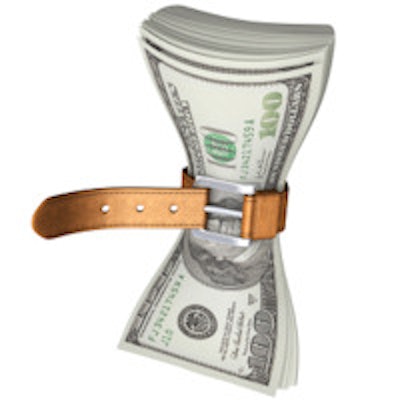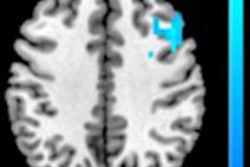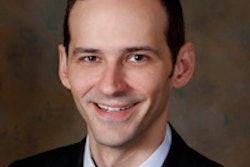
Radiology residents are prone to burnout even more than some other specialties, but their dilemma has less to do with the late nights, long hours, and strained interpersonal relationships than one might imagine. Instead, there is a familiar culprit: money, says a new study in Academic Radiology.
A major part of what is traditionally defined as burnout -- emotional exhaustion, social detachment, and feelings of low personal achievement resulting from prolonged occupational stress -- can be traced back to money woes, according to researchers from the University of Washington in Seattle.
"The objective financial data, specifically household income and debt levels, were somewhat predictive of burnout, but it was the responses they had to their subjective self-assessment of financial scarcity -- those were the ones that were really strongly predictive," lead author Dr. Michael McNeeley told AuntMinnie.com.
Previous studies of burnout have been conducted among residents in other medical specialties, but not in radiology, McNeeley said. Those studies focused on what might be called traditional contributors to the psychological syndrome of burnout: intense work, heavy schedules over which the worker has little control, and interpersonal relationships that are often strained due to work demands. But this study found that all of these factors, serious as they are, take a backseat to feelings of money scarcity.
"Financial instability has been shown to be a principal stressor for resident physicians," the authors wrote. "However, there remains a paucity of evidence regarding the specific influence of financial strain on burnout among medical trainees" (Academic Radiology, May 2013, Vol. 20:5, pp. 647-655).
Surveyed about their situation
The study was based on an electronic survey distributed to 1,389 resident and fellow junior members of the Association of University Radiologists in January 2012, with a reminder survey sent out four weeks later. The survey questions included demographic data; objective financial measures, including annual household income; total debt levels, excluding mortgages; and the respondents' moonlighting history. Complete responses were received from 266 residents (19%), which were analyzed for the study.
The residents had the opportunity to rate their institutions subjectively on an array of subjects ranging from financial support for books to medical licenses, American Board of Radiology-related expenses, travel, and so on. The survey used a numeric scale ranging from "no subsidy" to "full subsidy," McNeeley and colleagues wrote.
Subjective financial strain was assessed using six survey items. Participants were asked to rate their agreement with a series of statements on a seven-point scale, ranging from disagree to agree. Statements ran the gamut from "My current financial situation is a serious strain" and "I often think about my current financial situation" to "Due to my financial situation, I have difficulties paying for mandatory work-related expenses."
The study team assessed burnout symptomology using a version of the Maslach Burnout Inventory (MBI), a technique designed and validated with residents and used extensively to study the influence of stress on resident wellness. Items covered emotional exhaustion, depersonalization, and personal accomplishment, and were rated on a seven-point scale. The last section evaluated overall quality of life on a five-point scale.
A common side effect of residency
The results showed that most radiology residents reported high levels of personal achievement, but they also had symptoms of emotional exhaustion and depersonalization. Increasing levels of household debt were associated with symptoms of depersonalization and lower quality of life, but subjective financial experience was a more reliable indicator of well-being.
Survey results included the following:
- Forty-two percent of respondents said their personal finances made it difficult to pay for mandatory work-related expenses such as American Board of Radiology dues and licensing costs, while 25% reported at least some difficulty paying for housing and utilities.
- Higher levels of subjectively assessed financial strain were the best predictors of depersonalization, emotional exhaustion, and lower quality of life. Fifty-three percent of respondents described symptoms of emotional exhaustion at least weekly, and 49% reported feelings of depersonalization at least weekly.
- Quality of life was rated "as bad as it can be" or "generally bad" by 11% of residents, neutral by 27%, and "generally good" or "as good as it can be" by 62% of respondents.
- Women had slightly higher burnout scores than men (mean 15.14 versus 12.79), while age, parenthood, and training level were not significant predictors of burnout symptomology.
- Marital status wasn't a significant predictor of burnout, a finding consistent with some previous studies in other specialties; however, other studies have noted a slight tendency toward burnout among unmarried residents. Similarly, the presence of children in the family did not increase or decrease symptoms of burnout overall.
Overall, objective financial status was not correlated to burnout as related to money worries, according to McNeeley.
"You can look at two residents who are identical on paper -- both have $250,000 in debt; both have $50,000 household incomes -- but it's the attitudes about money that are tightly linked to their perceptions of emotional wellness," McNeeley said. "It's your subjective attitude regarding money that is key. If you feel financial scarcity, if you feel that strongly, then you're prone to burnout: It kind of makes sense."
Another finding, consistent with previous studies, is that moonlighting was correlated with higher levels of personal achievement and also higher quality of life, and the differences reached statistical significance, McNeeley said.
Less burnout in internal medicine?
Previous research by Jahoda (in Employment and unemployment: A social-psychological analysis) used similar methodology in its analysis of workers in general -- and found much less burnout compared to radiology trainees. McNeeley cautioned that there is no scientific method for avoiding burnout, but there are suggestions that may be helpful.
"The anecdotal advice is to stay physically active; maintain a strong social network -- and I mean the face-to-face kind, not the online kind; cultivate a spiritual life; and develop nonwork-related hobbies and interests," he said.
"If your job doesn't provide you with time structure, a sense of collective purpose, social contact, status, and stimulating activity, and if you're also burdened with a sense of financial scarcity, you're probably going to be prone to burnout ... even if your outside life and your home life is totally satisfactory," he added.
The question, then, is what institutional leaders, including department heads, program directors, physician groups, and others, can do about it. Throwing money at the problem might not help because residents' objective financial picture wasn't tied to burnout, but rather their own perceptions of strain, McNeeley said. Taking steps such as ensuring that employee time commitments are structured and meaningful and reinforcing social interaction among trainees and their families are likely to be more effective.
In that regard, departments should take care to treat employees as valuable members of the department and not just relative-value-unit (RVU) generators, he said.
"I think when you get out in private practice, there's a tendency to take a conveyer belt approach; there's this push for efficiency, and I think sometimes people forget that they're contributing to healthcare and that they're contributing to patient care even if it's indirect," he said.
It all comes back to Jahoda, who linked job satisfaction with time structure, routine activity, an enlarged social network, a sense of collective purpose, and enhanced social status. That study's methods were used to assess job satisfaction in the present study, McNeeley said.
For today's practice leaders, "I think those are the real high-yield strategies for avoiding burnout," he said. "Addressing the finances is only part of it, and it's probably not the meat of the issue. And I think that's good because these are all things you can do."



















